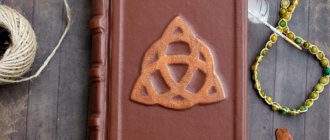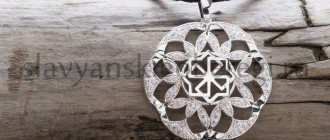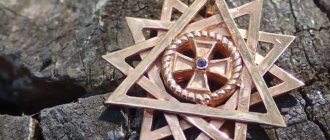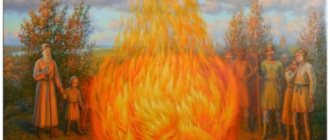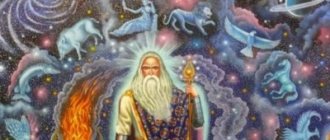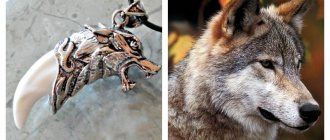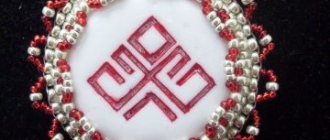What does the Chur amulet look like?
The talisman is made from various materials. It can be silver, bronze, brass and even wood. The amulet consists of three diamonds of the same size, intertwined with straight lines tending downwards. If you look closely, it resembles the figure of a man who, with his arms akimbo, stands straight and proud.
Chur has remarkable protective power, which is due to its mythological origin. Craftsmen make the amulet by hand with good intentions and good parting words for the future owner of the talisman. In order to enhance its properties, the pendant is charmed, charged and spiritualized. This is not just a decoration, it is a powerful and pure artifact.
Who does it help?
Not every person can benefit from the Chur amulet. To count on the protection of an ancient Slavic symbol, you need to be:
- an honest person;
- do not wish harm to others;
- to work a lot;
- achieve everything on your own.
Usage
The Chur amulet is worn on the body to protect outside the home from the evil eye, to attract good luck, and to gain wisdom. The talisman is also placed in a pocket, purse, bag - this helps to attract material well-being. To protect the house, the amulet is placed indoors, but so that it is hidden from prying eyes.
Depending on where it is placed, the symbol performs certain functions:
- above the threshold - protects from enemies, attracts good guests;
- in the living room - helps to establish contacts with visitors to the house;
- in the nursery – gives the child health and happiness;
- above the bed – relieves insomnia;
- in the center of the room – protects the room from theft and fire;
- among jewelry - attracts wealth;
- in a pregnant woman’s room – promotes the birth of a healthy baby;
- next to clothes (in the closet, on a hanger) - protects housing and a person at the same time, since things
- charge and continue to influence the owner when he is away from home.
The amulet in the form of a figurine of a man standing with his hips akimbo in a confident pose is made from different materials (silver, bronze, brass, clay, wood, fabric). The silver amulet has the greatest power.
It is best to make the amulet yourself (you can simply draw three diamonds with lines on any object). If the amulet is purchased in a store, it should be washed with water and the wooden product should be cleaned with salt.
How the symbol appeared
There is a legend: after the creation of the world, the supreme Slavic God Svarog ordered his grandson to distribute land plots among people according to his conscience. Having descended from heaven, the grandson of Svarog heard voices from all corners of the earth. People kept shouting: “I’m sorry, this is mine!” Each of them tried to shout to God and get the largest piece of land.
Chur ordered the Slavs to mark the boundaries of their plots using wooden posts. No one had the right to touch or move them without informing the owner. In order to scare away the dark forces and notify everyone around them of powerful protection, people began to carve symbols and the face of a just God on border pillars. Over time, amulets began to appear that protected from the evil eye, protected the home and preserved the family hearth.
Appearance of the amulet
The amulet looks like a schematic image of a person with his hands on his hips. The chur symbol is drawn as 3 rhombuses, the central one is located slightly higher than the two lateral ones, which are on the same level.
The lateral rhombuses of one of the sides continue to the center of the figure, forming a cross between themselves, then descend down in the form of 2 vertical lines. Between them there is, as it were, a continuation of the central rhombus in the form of a pillar formed by 2 parallel lines connected at the top by an arch.
BY THE WAY! It is believed that initially the chura sign looked completely different - like an image of a small old man with long hair and a beard, his hands on his hips.
Such a design was applied to wooden chocks or logs (the name of which, according to some authors, also comes from Chur).
The modern chur amulet is precisely a schematic version, usually made in wood or silver in the form of a ring, pendant, keychain, etc.
The image is also applied to fabric in the form of embroidery and the body in the form of a tattoo. Usually the amulet is made of silver, which enhances its protective properties.
You may be interested in: The meaning of the Slavic symbol fern flower (Perunov color)
The Legend of God Chur
Little information about the life of our ancestors has reached our times. It is known for certain that God Chur did not belong to the highest divine pantheon, but despite this he was one of the most revered. According to legend, Veles’s army was divided: some remained in heaven, and some descended to earth in order to help people and protect them from adversity. God Chur volunteered to protect people from misfortune.
God Chur has a huge influence on all living things. It is he who stands on the border between two worlds, commands the brownies and protects people from otherworldly dark forces. Our ancestors believed that without his help and patronage it would be impossible to complete any work begun. God Chur protects not only human possessions, but also the soul.
History of the origin of the amulet
According to the most common version, the origin of the “chur” symbol comes down to the name of a Slavic deity.
At the same time, many researchers consider the god Chur himself to have never existed in Slavic mythology, but to have been attributed to it later (in the 15th – 19th centuries) as part of attempts to adapt Slavic paganism to a system similar to Greek and Roman religious views.
The names of deities in this approach were usually extracted from extant texts, songs and tales. So, “chur” in this sense has several meanings:
- as an interjection in a number of East Slavic dialects (some authors believe that it may be related to the word “devil”, while others argue that this word comes from the Greek “lord” and means an exclamation like “God forbid!”);
- as the name of the Slavic god of the hearth (an image most likely derived similarly to the Roman Terminus - the god-guardian of borders, from whose name came the terms - columns with a bust of a man on top). There is an opinion that the name of chocks and blocks, used as boundary marks, also came from the word “chur”;
- as the deified spirit of an ancestor (or ancestors), from which the concept of “ancestor” originated;
- as a phallic symbol (according to one of the researchers, N.K. Tolstoy, the Slavs often used the mention of male genitalia to ward off evil spirits).
ATTENTION! There is no consensus on the origin of the term “chur”, and, consequently, the corresponding Slavic amulet. This problem is associated with the lack of a unified system of beliefs among the Slavs, as well as with the fact that information about Slavic paganism is almost completely reconstructed based on the study of folklore and language.
The Legend of the God Chur
According to the version in which the amulet is associated specifically with a deity, the corresponding god is a descendant of Rod (the creator of the world), created specifically for protective purposes and is closer to people than all other deities.
Some researchers associate with him (and with Veles) the emergence of Rez Rod (a rune-like pre-Christian writing), which the pagans used to tell fortunes.
You may be interested in: Slavic amulet Kolyadnik: The meaning of the symbol
In addition, the god Chura is also identified with deceased ancestors who preserve their family. Chura is also called in some sources the lord of brownies and the guardian of people from evil forces.
It is believed that Chur is able to change his appearance: he can be an old man, a young man, or a white wolf with blue eyes.
There is also a legend according to which Chur is the grandson of Svarog (the god who completed the creation of the world begun by Rod). When Svarog completed the creation of the earth, he instructed his grandson to divide it among people.
When dividing the land, people said: “Church, mine!”, designating their territory. At the end of the division, Svarog’s grandson told people to place wooden posts on the borders as boundary signs (they later began to be called “blocks” or “chocks” and carve an image of the corresponding deity on them).
About the meaning of the talisman
Our ancestors resorted to the help of the Chur amulet in various situations. For example, to clear a place for further magical rituals. The talisman was used to protect against evil spirits and evil spirits. The amulet is universal and helps the owner:
- protect property;
- protect housing from fires, floods and robberies;
- bring any work started to completion;
- protect yourself from the evil eye, the bad influence of bad people;
- fill the house with well-being;
- protect the soul from the influence of evil spirits;
- help in work, contribute to making a profit;
- improve relationships between relatives;
- comprehend the wisdom of our ancestors;
- protect the family from collapse, ruin, and lack of money.
The Chur amulet favors those people who are sincere and pure in their thoughts, do not wish harm to others, love to work and achieve everything on their own. The talisman will help those who are afraid of deception and unfair treatment.
The meaning of the Chur symbol
Experts in folk wisdom believe that the god Chur is on the border of two worlds, controls the brownies, protects not only the body, property, but also the soul of a person.
Our ancestors used Chur for different purposes:
- Served as protection against evil spirits. In a moment of danger, a person cried out: “Cheers, not me!”, and trouble passed by. It was as if a person protected himself with a magic circle that evil spirits could not cross.
- Helped to obtain property. When the supreme god instructed his grandson to manage the open spaces in good conscience, during the distribution of land, people shouted: “Church, me!”, and secured the right to own the plot for themselves.
- It was used to mark boundaries and boundaries. They carved the symbol on the border posts.
- With its help, they cleared the place for magical rituals.
- In a figurative sense, the word “shiver” was used, which meant the desire to isolate oneself from contacts with a certain person or group of people. This was how they expressed dissatisfaction and disapproval.
The meaning of the Chur amulet is universal; it is suitable for all people (regardless of gender, age, zodiac sign):
- protects property, especially land plots;
- protects the home from fire, flooding and burglars;
- contributes to filling the home with well-being and prosperity;
- helps to bring everything started to completion;
- protects against the evil eye (relevant for children), generational curses, negative influences, slander from bad people;
- helps in work, helps to obtain increased profits (used by businessmen);
- protects the soul from the influence of evil spirits (necessary for those who find themselves in a difficult situation);
- helps to penetrate the depths of the wisdom of ancestors;
- protects the family from want, poverty, ruin (used by a man - the head of the family);
- helps relatives establish good relationships with each other (needed by women who are the custodians of the family hearth).
If you are afraid of deception, have been subjected to unfair treatment and have lost faith in your own strength, the Chur amulet will save you.
Who is the talisman suitable for?
The amulet can be worn both small and large. It is universal and suits everyone. The child will be protected from the evil eye and the bad influence of bad people. It will help a woman strengthen the bonds of marriage and improve relationships with all family members. For a man, the talisman is favorable in resolving various issues related to money, real estate and other property.
The amulet is chosen by people who do business. It contributes to making a profit, helps in finding reliable partners and solving various work issues. The Chur talisman will help you out in difficult times, guide you on the right path, clear your thoughts and get rid of negativity.
Application
The scope of application of the talisman is quite diverse. As a rule, the amulet is worn on the body, on a silver chain or leather cord. It can be hidden in a purse, bag or pocket. You can store the talisman at home. But you shouldn’t leave it in a visible place. It’s better to hide it from prying eyes, so its influence will increase on all family members.
The amulet is reliable protection for those who want to achieve financial independence and move up the career ladder. It will protect the house from evil spirits and bad people, and will help improve relations between all family members.
History of the Slavs
The Slavic people are relatively young. Mentions of it can be found in written sources from the 6th century. n. e., and the birthplace of this people, apparently, was the territory north of the Carpathians. The problem of the emergence and settlement of the Slavs still remains controversial in the scientific community, but the overall picture is as follows: in the middle of the first millennium AD, a circle of East Slavic tribes formed on the territory of Eastern Europe - Slovenes, Vyatichi, Krivichi, Dregovichi and many others.
It cannot be said that they had a clear, established range of beliefs. There is currently no information about a single mythology of the ancient Slavs, and it is unlikely that it will ever appear. Slavic paganism did not reach the same high point as, for example, Greek or Indian paganism, and did not develop its own myths and tales. However, fragmentary information has been preserved about the lower representatives (goblins, brownies and kikimors) and the Slavic gods. In studying the beliefs of our ancestors - the ancient Slavs - scientists rely both on data from ethnography and folkloristics, and on archeology. The latter often provides us with material evidence of those times when paganism was still alive and widespread - in particular, these are wooden statues of Slavic gods.


